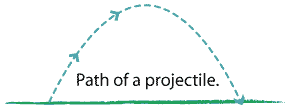History and applications
The history of the algebraic aspects of quadratics was covered in the module Quadratic equations (Years 9–10) ![]() .
.
Historically, the geometric properties of the parabola were studied by the ancient Greeks. Menaechmus (c. 380–320 BCE) appears to have been the first to study the properties of the parabola along with the hyperbola and ellipse. These curves arose through the study of the cone. Apollonius of Perga (262–190 BCE) wrote a major treatise on the conic sections, but his definition of the parabola was in terms of ratios and without any use of coordinates. The focus-directrix definition used in this module goes back to Pappus (290–350 CE). It was not until the advent of coordinate geometry at the time of Descartes that further real progress could be made, although the reflective property was known to the Greeks.
 Galileo (1564–1642) realised that the motion of a projectile under gravity formed a parabolic path. Kepler (1571–1630) was the first to realise that the planets revolve around the sun in orbits that are very close to being elliptical. Newton proved this using his universal law of gravitation and the calculus.
Galileo (1564–1642) realised that the motion of a projectile under gravity formed a parabolic path. Kepler (1571–1630) was the first to realise that the planets revolve around the sun in orbits that are very close to being elliptical. Newton proved this using his universal law of gravitation and the calculus.
The reflective properties of the parabola and the ellipse have been exploited in architecture to obtain remarkable acoustic properties in large church buildings, and later in the design of powerful telescopes and reflectors.
